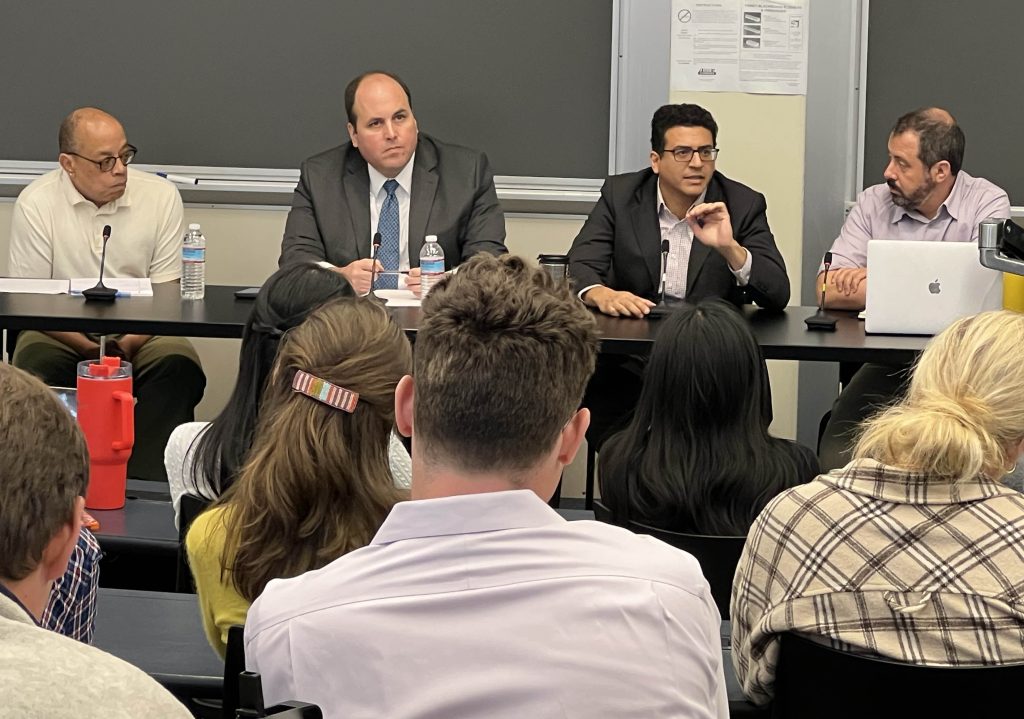East Wing 120 was packed to overflowing on September 20 as students and community members gathered for a panel discussion on the landmark SCOTUS decision in Students for Fair Admissions v. Harvard and its companion case, Students for Fair Admissions v. University of North Carolina.
BC Law Professors Daniel Farbman, Aziz Rana, Ryan Williams, and Rappaport Distinguished Visiting Professor Jeffery Robinson explained the complexities of law and legal precedent involved in the decisions, and how they might influence future cases.
The cases, decided in June in a 6-3 split along party lines (Justice Jackson recused herself from the Harvard case but joined Justices Sotomayor and Kagan in the slip opinion dissent), upended race-based affirmative action in the United States after decades of validation by the nation’s highest court.
Dean Odette Lienau introduced the hourlong session by calling for careful and respectful engagement with the topic. “A law school must do all that it can within the limits of the law to ensure that we’re preparing a legal profession that can understand and attend to the full range of perspectives and experiences in society,” she said, “including those colored by ongoing structures of racial injustice.”
Rana, a noted scholar of constitutional law, race, and citizenship, encapsulated “fifty plus years of post-civil rights experience,” situating the room at the moment in time just after the end of formal, legal segregation in the United States circa 1964: With the passage of the Civil Rights Act and its companion legislation, the civil rights movement had struck a blow against racial discrimination, but more pervasive forms of inequality persisted, he noted.
In response to these issues, labor and civil rights activists like A. Philip Randolph and Dr. Martin Luther King, Jr. called for the adoption of the “Freedom Budget,” a proposal intended to alleviate poverty and other economic issues felt disproportionately by Black Americans. “Alongside that proactive agenda,” Rana said, “was another project, much smaller in scope: To use race-conscious remedies including, for instance, race criteria in assigning children to schools, ensuring that no school diverts too dramatically from the overall racial composition of the district.” But where the Freedom Budget failed to break through—it was largely subsumed by President Johnson’s Great Society program—race-conscious remedies continued on as a tool to combat de facto segregation.
In 1978, the Supreme Court upheld affirmative action broadly in Regents of the University of California v. Bakke, holding that, while strict racial admissions quotas were unconstitutional, race was a proper factor (considered among others) on which admissions policies could be based, Rana explained. Although the Court’s plurality opinion, authored by Justice Lewis Powell, seemed to shut out the argument that affirmative action was permissible as a tool to “remedy past forms of discrimination,” there was a possible justification that legitimated the program: diversity.
“This justification [diversity] was something that civil rights activists viewed as an incredibly hollow victory—consideration of race to address deep-rooted forms of discrimination had collapsed. Affirmative action in higher education survived only on the condition that litigants and activists refrain from talking about the question of racial discrimination, which was the entire purpose of these remedies in the first place,” Rana argued.
The diversity justification was affirmed, 25 years later, in another SCOTUS case, Grutter v. Bollinger. There, Justice Sandra Day O’Connor wrote that consideration of race in higher education admissions “further[ed] a compelling interest in obtaining the education benefits that flow from a diverse student body.” In that 2003 opinion, Rana noted, Justice O’Connor wrote that she expected that “25 years from now, the use of racial preferences will no longer be necessary to further the interest approved today.”
In summation, Rana offered this analysis: “We are in a moment where there’s a gulf between the larger conversation about the nature of race, equality, education, and meritocracy, and the conversation the [Supreme] Court is having, and figuring out how to link the two is, in many ways, the project of the present and future.”
Professor Williams introduced the cases decided by the SCOTUS this term, which largely abrogated Bakke and Grutter. The plaintiff in both cases, Students for Fair Admissions, is a “non-profit organization whose goal is to challenge programs like affirmative action,” Williams said. “Their theory of standing is that they have members that will be adversely affected by race-conscious admissions decisions.”
The defendants, the University of North Carolina and Harvard, are both bound by non-discrimination requirements: As a public institution, the University of North Carolina is “directly bound by the requirements of the Protection Clause of the Fourteenth Amendment,” Williams said, while Harvard, “a private institution and, therefore, not directly bound by the Fourteenth Amendment” is nevertheless “subject to the requirements of Title VI of the Civil Rights Act of 1964” because it receives federal funding.


